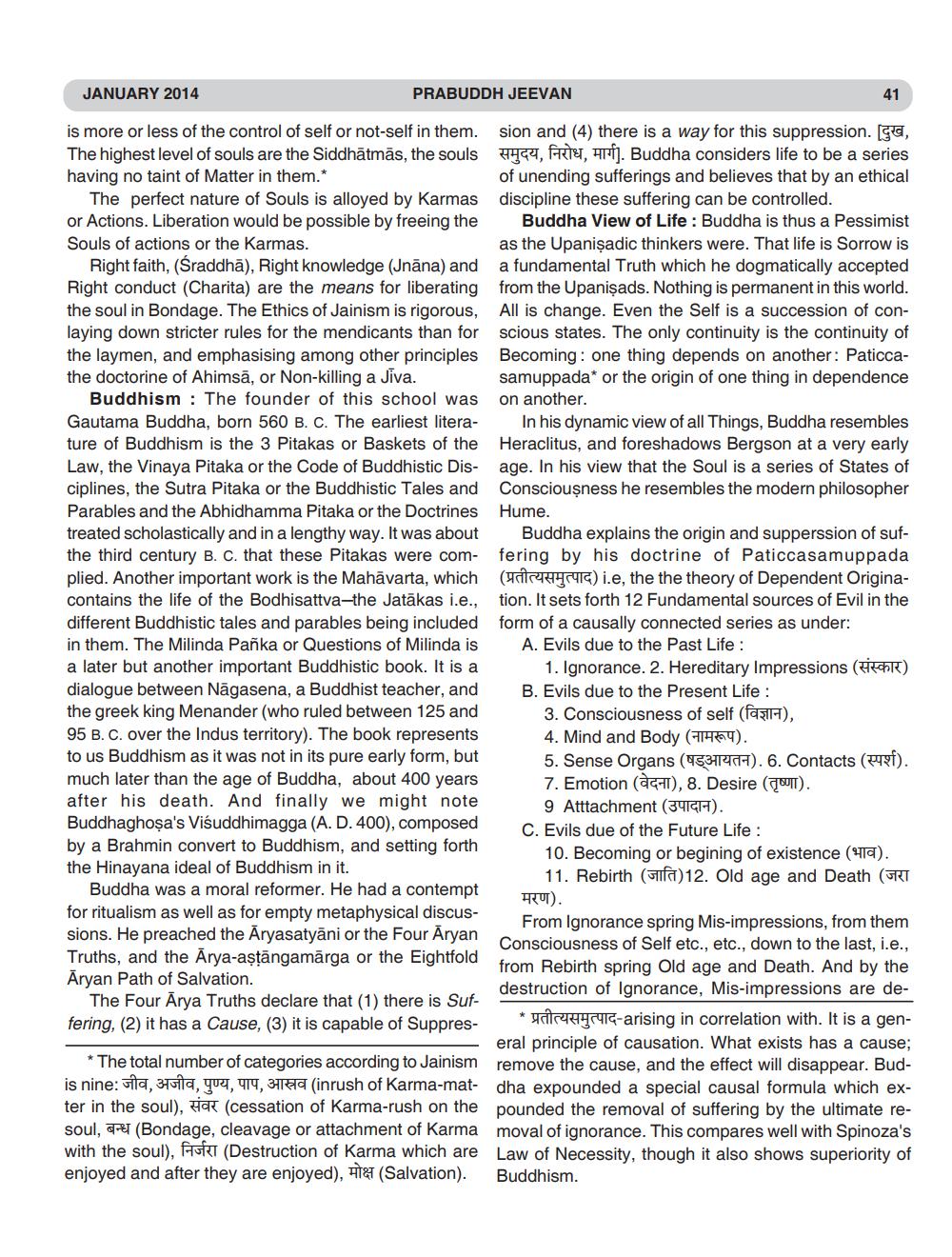________________
JANUARY 2014
is more or less of the control of self or not-self in them. The highest level of souls are the Siddhātmās, the souls having no taint of Matter in them.*
PRABUDDH JEEVAN
The perfect nature of Souls is alloyed by Karmas or Actions. Liberation would be possible by freeing the Souls of actions or the Karmas.
Right faith, (Śraddha), Right knowledge (Jnāna) and Right conduct (Charita) are the means for liberating the soul in Bondage. The Ethics of Jainism is rigorous, laying down stricter rules for the mendicants than for the laymen, and emphasising among other principles the doctorine of Ahimsā, or Non-killing a Jiva.
Buddhism: The founder of this school was Gautama Buddha, born 560 B. C. The earliest literature of Buddhism is the 3 Pitakas or Baskets of the Law, the Vinaya Pitaka or the Code of Buddhistic Disciplines, the Sutra Pitaka or the Buddhistic Tales and Parables and the Abhidhamma Pitaka or the Doctrines treated scholastically and in a lengthy way. It was about the third century B. C. that these Pitakas were complied. Another important work is the Mahāvarta, which contains the life of the Bodhisattva-the Jatākas i.e., different Buddhistic tales and parables being included in them. The Milinda Pañka or Questions of Milinda is a later but another important Buddhistic book. It is a dialogue between Nagasena, a Buddhist teacher, and the greek king Menander (who ruled between 125 and 95 B. C. over the Indus territory). The book represents to us Buddhism as it was not in its pure early form, but much later than the age of Buddha, about 400 years after his death. And finally we might note Buddhaghosa's Visuddhimagga (A. D. 400), composed by a Brahmin convert to Buddhism, and setting forth the Hinayana ideal of Buddhism in it.
Buddha was a moral reformer. He had a contempt for ritualism as well as for empty metaphysical discus
sions. He preached the Aryasatyani or the Four Aryan Truths, and the Arya-aṣṭāngamarga or the Eightfold Aryan Path of Salvation.
The Four Arya Truths declare that (1) there is Suffering, (2) it has a Cause, (3) it is capable of Suppres
*The total number of categories according to Jainism is nine: la, la, yo, 1, (inrush of Karma-matter in the soul), a (cessation of Karma-rush on the soul, (Bondage, cleavage or attachment of Karma with the soul), FT (Destruction of Karma which are enjoyed and after they are enjoyed), the (Salvation).
41
sion and (4) there is a way for this suppression. [, समुदय, निरोध, मार्ग ]. Buddha considers life to be a series of unending sufferings and believes that by an ethical discipline these suffering can be controlled.
Buddha View of Life: Buddha is thus a Pessimist as the Upanisadic thinkers were. That life is Sorrow is a fundamental Truth which he dogmatically accepted from the Upanisads. Nothing is permanent in this world. All is change. Even the Self is a succession of conscious states. The only continuity is the continuity of Becoming: one thing depends on another: Paticcasamuppada* or the origin of one thing in dependence on another.
In his dynamic view of all Things, Buddha resembles Heraclitus, and foreshadows Bergson at a very early age. In his view that the Soul is a series of States of Consciousness he resembles the modern philosopher Hume.
Buddha explains the origin and supperssion of suffering by his doctrine of Paticcasamuppada (g) ie, the the theory of Dependent Origination. It sets forth 12 Fundamental sources of Evil in the form of a causally connected series as under: A. Evils due to the Past Life:
1. Ignorance. 2. Hereditary Impressions (+) B. Evils due to the Present Life :
3. Consciousness of self (f),
4. Mind and Body (14).
5. Sense Organs (4). 6. Contacts (f). 7. Emotion (a), 8. Desire (IT).
9 Atttachment (34).
C. Evils due of the Future Life :
10. Becoming or begining of existence (). 11. Rebirth (f)12. Old age and Death (RT मरण).
From Ignorance spring Mis-impressions, from them
Consciousness of Self etc., etc., down to the last, i.e., from Rebirth spring Old age and Death. And by the destruction of Ignorance, Mis-impressions are de
-arising in correlation with. It is a general principle of causation. What exists has a cause; remove the cause, and the effect will disappear. Buddha expounded a special causal formula which expounded the removal of suffering by the ultimate removal of ignorance. This compares well with Spinoza's Law of Necessity, though it also shows superiority of Buddhism.




